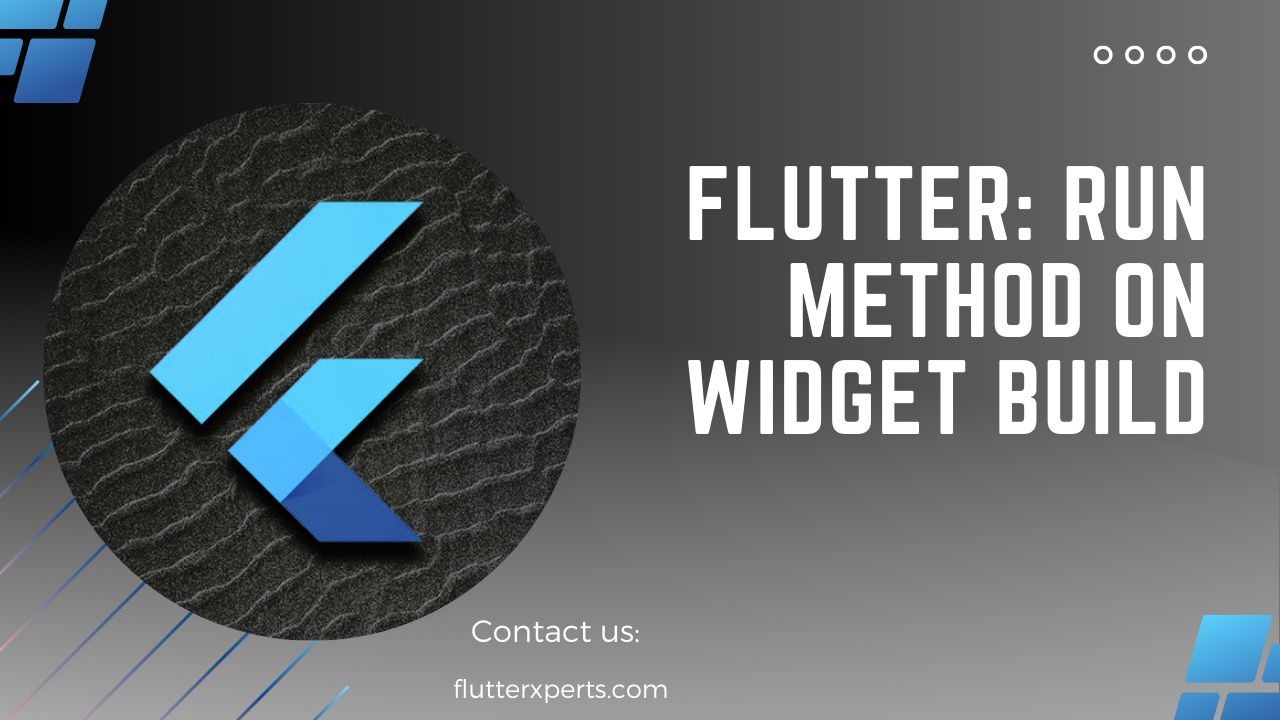Code Example: Executing a Method after Widget Build in Flutter
Introduction
Welcome to our technical blog on Flutter mobile app development! In this article, we’ll explore the concept of executing a method after the completion of the Widget build process in Flutter. We’ll provide you with a step-by-step guide and code examples to help you implement this functionality in your Flutter applications. So, let’s dive in!
Understanding Widget Build in Flutter
Before we delve into running a method on Widget build, let’s gain a clear understanding of how the Widget build process works in Flutter. In Flutter, the build method is responsible for constructing the widget tree that represents the user interface of your application. It is called whenever the state of the widget changes, prompting a rebuild of the UI. Understanding this process is crucial for executing a method after the completion of Widget build.
Running a Method on Widget Build
To run a method after the Widget build process is complete, we can make use of the WidgetsBinding class in Flutter. The WidgetsBinding provides a mechanism to listen for lifecycle events, including the completion of the Widget build process. By leveraging this feature, we can execute our desired method once the build process is finished.
Here’s an example of how you can achieve this:
class MyWidget extends StatefulWidget {
@override
_MyWidgetState createState() => _MyWidgetState();
}
class _MyWidgetState extends State<MyWidget> with WidgetsBindingObserver {
@override
void initState() {
super.initState();
WidgetsBinding.instance!.addObserver(this);
}
@override
void dispose() {
WidgetsBinding.instance!.removeObserver(this);
super.dispose();
}
@override
void didChangeAppLifecycleState(AppLifecycleState state) {
if (state == AppLifecycleState.resumed) {
_executeAfterBuild();
}
}
void _executeAfterBuild() {
// Your method code here
// This method will be executed after Widget build is complete
}
@override
Widget build(BuildContext context) {
// Widget build implementation
return Container();
}
}
In the above code snippet, we create a StatefulWidget called MyWidget and implement the WidgetsBindingObserver mixin. We override the initState method to add ourselves as an observer to the WidgetsBinding instance. This allows us to receive lifecycle events.
Next, we override the didChangeAppLifecycleState method to listen for the resumed state. This state indicates that the app is visible and interactive. When the app enters this state, we call our _executeAfterBuild method, which contains the code you want to run after the completion of the Widget build.
Finally, in the build method, we return a Container widget as a placeholder for your UI implementation.
Code Example: Flutter Run Method on Widget Build
Now that you understand the concept of running a method after Widget build, let’s walk through a complete code example to solidify your understanding. In this example, we’ll create a simple Flutter app that displays a button and executes a method after the Widget build process is complete.
import 'package:flutter/material.dart';
void main() {
runApp(MyApp());
}
class MyApp extends StatelessWidget {
@override
Widget build(BuildContext context) {
return MaterialApp(
title: 'Widget Build Example',
home: Scaffold(
appBar: AppBar(
title: Text('Widget Build Example'),
),
body: MyWidget(),
),
);
}
}
class MyWidget extends StatefulWidget {
@override
_MyWidgetState createState() => _MyWidgetState();
}
class _MyWidgetState extends State<MyWidget> with WidgetsBindingObserver {
@override
void initState() {
super.initState();
WidgetsBinding.instance!.addObserver(this);
}
@override
void dispose() {
WidgetsBinding.instance!.removeObserver(this);
super.dispose();
}
@override
void didChangeAppLifecycleState(AppLifecycleState state) {
if (state == AppLifecycleState.resumed) {
_executeAfterBuild();
}
}
void _executeAfterBuild() {
showDialog(
context: context,
builder: (BuildContext context) {
return AlertDialog(
title: Text('Method Execution'),
content: Text('Method executed after Widget build.'),
actions: [
TextButton(
onPressed: () {
Navigator.of(context).pop();
},
child: Text('Close'),
),
],
);
},
);
}
@override
Widget build(BuildContext context) {
return Center(
child: ElevatedButton(
onPressed: () {
// Trigger a rebuild
setState(() {});
},
child: Text('Rebuild Widget'),
),
);
}
}
In this example, we define a Flutter app with a button widget inside the MyWidget widget. The MyWidget class implements the WidgetsBindingObserver mixin to observe lifecycle events. When the app is resumed, the _executeAfterBuild method is called, displaying an alert dialog to indicate the execution of the method after Widget build.
Conclusion
In this blog post, we explored how to execute a method after the completion of Widget build in Flutter. We learned about the Widget build process and utilized the WidgetsBinding class to listen for lifecycle events. By following the code examples and step-by-step guide provided, you can incorporate this functionality into your Flutter applications.
If you have any further questions or need clarification, feel free to leave a comment below. Happy coding!
FAQs
Q1: Can I run multiple methods after Widget build using this approach?
Absolutely! You can extend the example by adding multiple methods to the _executeAfterBuild method and executing them all after the Widget build process is complete.
Q2: Is it possible to run a method before Widget build?
Yes, it is. To run a method before Widget build, you can override the initState method in your StatefulWidget and call your desired method there. This method will be executed before the Widget build process begins.


